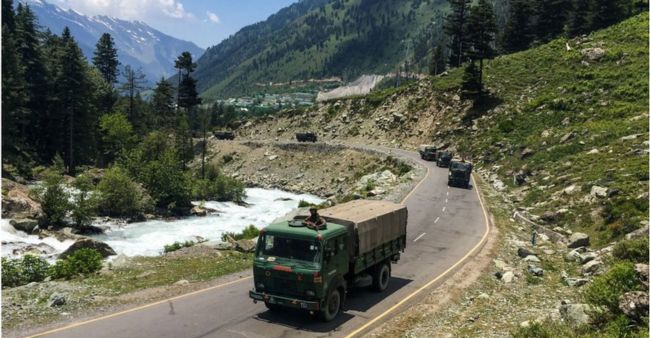Since the bloody clash between Chinese and Indian soldiers on the Line of Actual Control (LAC) in Eastern Ladakh on the night of 14-15 June 2020, numerous significant developments have unfolded, the most notable being the increased military presence on both sides of the LAC. Subsequent to the Galwan incident, a total of 18 rounds of Corps-Commander level meetings have taken place between the Chinese and Indian Armies. These meetings have yielded some positive outcomes, leading to the disengagement of forces from both sides at certain locations. The primary purpose of these meetings is to establish a military buffer zone. However, the forces are still deployed. In fact several permanent and temporary structures have been erected on the Chinese side of the LAC. Satellite images from February 2023 substantiate the existence of these structural installations.
In 2021, China enacted the “Land Border” law, with the primary objective of enhancing security, as well as social and economic development along its borders. This law established the legal foundation for the Chinese government to expedite the construction of civilian and military infrastructure in the border regions. A recent report from the Pentagon indicates that following the Galwan clash, the Chinese military has strengthened its infrastructure in close proximity to the LAC. In response, the Indian Army too has maintained a significant presence through every season. Hence, as long as the boundaries remain undefined, the possibility of incidents like Galwan will persist.
In 2013, India and China signed the “Border Defence Cooperation” agreement, reiterating their full commitment to implementing the 1993 and 2005 agreements. These agreements clearly stipulated that neither country would employ their military capabilities against each other. However, during the Galwan conflict, Chinese soldiers deviated from this agreement by employing heavy batons and sharp objects, some of which were equipped with barbed wires. And now numerous media reports and photographs from March 2022 onwards indicate that Chinese soldiers are being equipped with deadlier hand-to-hand combat weapons.
The primary concern during the recent 18th round of India-China Corps Commander talks centred around the three-year-long military standoff along the LAC. The standoff remains unresolved in areas such as Depsang Plains and Demchok. Over the past three years, bilateral discussions have been conducted at various levels, encompassing both military and diplomatic channels. Some progress has been made, leading to the withdrawal of troops from numerous locations. The Northern Command of the Indian Army has ensured that no intrusion takes place along the LAC. The Indian Army has captured several mountain peaks and ridgelines, because of which the Chinese troops have had to retreat from sensitive places. Disengagement has happened in roughly four phases: at Galwan Valley, in the area around Pangong-Tso, at some patrolling points at Gogra and at one patrolling point at Hot-Spring. Several estimates suggest that at least 50,000 soldiers from both sides are still deployed along the LAC. Even three years after the Galwan clash, China’s persistent aggressive policies and expansionist intentions continue to raise concerns in India. A clear illustration of this is the extensive network of roads that China has developed, granting its troops improved and convenient access to the LAC. Moreover, China has constructed a bridge in the Pangong-Tso area. China also maintains a strong presence in the Aksai-Chin region and has been involved in activities within the Depsang Plains. These factors collectively contribute to India’s ongoing vigilance and wariness.
Three years have passed, yet certain questions remain unanswered. Among these lingering inquiries, the most significant one pertains to China’s aggressive actions in the Galwan Valley in June 2020. Despite extensive analysis, a definitive answer still eludes us. Some analysts propose several explanations, including China’s desire to disrupt India’s infrastructural development along the LAC and their reaction to the reorganization of Jammu and Kashmir. Additionally, a hypothesis suggests that China aimed to issue a warning and solidify its control over Aksai Chin.
We have witnessed significant shifts in global diplomacy in the last three years. The conflict in Galwan, the concerns regarding Taiwan’s sovereignty and China’s actions in the South China Sea all speak of China’s expansionist policy. Furthermore, the Covid-19 pandemic has led to a certain level of antagonism from the international community towards China. Consequently, India has placed significant emphasis on its relations with the Quad, recognizing the importance of this alliance in the current geopolitical landscape. The multinational Malabar Exercise has undergone an expansion. India has vehemently criticized from international platforms those with intentions to disrupt sovereignty and unilaterally alter borders. Meanwhile, China has been actively forging new alliances, strengthening its ties with Russia, and simultaneously cultivating fresh relationships with the Arab countries.
For the past three years, India has conveyed to China and the world that normalization of relations is difficult until the current border issues are resolved. However, China has been maintaining that the two sides should put aside border troubles and move forward on other aspects. How is it possible when the troops

